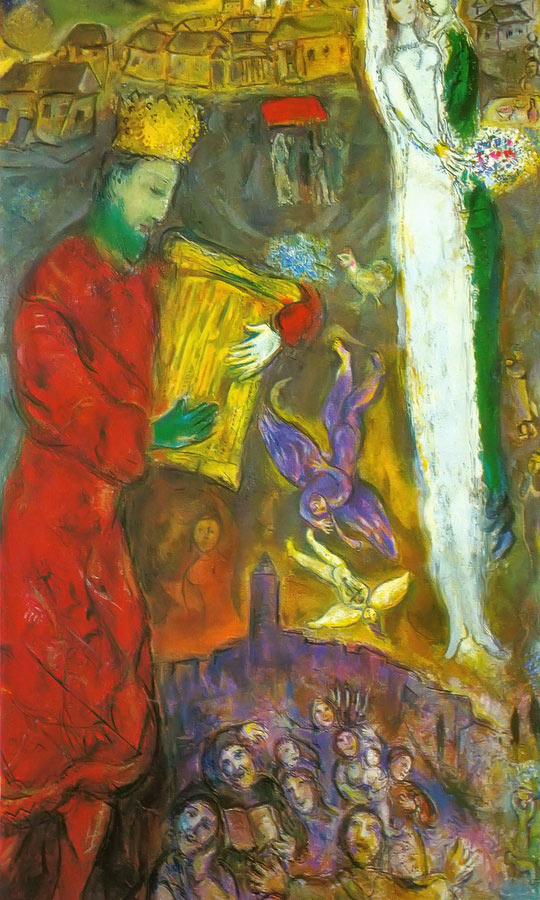
King David -- Marc Chagall
We were having a low-key conversation about empires not long ago, a result of the regular and shocking evidence that the nation to the south of us is coming unraveled, despite claims about "Making America Great Again." So much about empires depends on the hype and who tells the story. I commented to Ruth that I grew up with the impression that the biblical King David who lived roughly a thousand years before Jesus was a big cheese, and he certainly is in the bible. Jesus is described as being of the "house and lineage of David" and there is no doubt that the drama of David's life, from shepherd-boy-makes-good, to rebel with a cause, to troubled monarch who is too big for his spiritual britches is the stuff of legends.
I didn't realize until my seminary days that while David is vital to our Judeo/Christian story he was more of a character actor than a bonafide star on the world stage of his era. Some scholars have argued that neither David nor any of the other patriarchs actually existed. At first that unsettled me, but then I appreciated that this didn't really diminish the timeless aspects of the David story for my faith.
I came upon a New Yorker article about David -- yet another one -- which explores the tensions in the scholarly world, which are often quite adversarial. The two principals in the debate are Finkelstein and Garfinkel, who I thought were a folk rock duo of the 1970's. Ruth Margalit's piece In Search of King David’s Lost Empire describes Finkelstein's take on the flawed monarch:
Their leader is a wily, resourceful man from Bethlehem, who decides that his people are meant for more than lightning raids and mercenary stints. He sends his men to rout an advancing force, then shares the loot with the highland elders. This wins over the highlanders, and, in time, they make him chieftain of the southern hill area. He takes over the tribal center of Hebron, and later captures Jerusalem, another hilltop stronghold. The chieftain moves his extended family to the main homes of the Jerusalem village, and settles in one himself—a palace, some might call it, though there is nothing extravagant about it. He rules over a neglected chiefdom of pastoralists and outlaws. His name is David.
Israel Finkelstein’s vision of King David—the vagabond, the racketeer—helped make his career as an eminent Biblical archeologist
Later in the piece Margalit describes Garfinkel's perception of David:
Garfinkel argues, David led an unprecedented political transformation. In a region surrounded by autonomous city-states, he slowly forms a kingdom. He builds a city, establishes a tax system, fosters a court of scribes. To confer legitimacy, he brings an old relic, known as the Ark of the Covenant, to Jerusalem, where it helps to anchor a centralized cult. His son erects a palace, large enough to store a year’s worth of oil and wine, and a temple, built from Lebanon cedar overlaid with gold.
“David was the greatest genius who ever lived between the Mediterranean and Jordan,” Garfinkel told me. “So what do they do? They come in and erase him. In a thousand years, no one will know who Garfinkel or Finkelstein or the minimalists are, but they will all know who David is.” Garfinkel has called his discovery of Qeiyafa “a death blow to minimalists.”
Here's what I figure. David existed, and while we can't be exactly sure of who he was or what he accomplished, his importance within Judaism, Christianity, and Islam endures. He will be remembered long after the Emperor Orange is just a make-up smear in the annals of history.
https://www.newyorker.com/magazine/2020/06/29/in-search-of-king-davids-lost-empire
David with the Head of Goliath -- Caravaggio
No comments:
Post a Comment